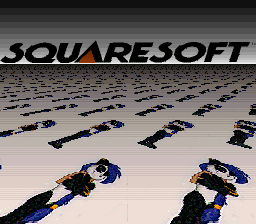Squaresoft Mode 7 Demo is a “tech demo” made by Sunsoft for testing the system hardware of the Super Nintendo…
Squaresoft Mode 7 starts with Squaresoft logo and appears a exclusive “panda” on the screen:

The name of this character has been discovered with the ROM IMAGE, Panda Squaresoft Mode 7 Demo (PD) showed up on an SuperNintendo Emulator. You can read more about this cartridge at SNES Central!
Back in the mid 90s, Square set up a studio in Redmond, Washington, and produced the game Secret of Evermore. Keith and another person named Craig Bergman got to tour Squaresoft’s office as part of a high school job shadowing activity. While there, Squaresoft scanned and put two drawings made by Keith happened to have into a Mode 7 demo (the other had a caricature of Craig).
In July 2010, this cartridge has appeared on Ebay, the curious about it, this demo have an similar controls to the airship parts of FFIV. This tech demo has been dumped years ago, and posted at the Internet
About the controls, you can flip the camera, zoom in, and stop the animation with start button… That’s all
Also, the scanned “panda” character made by Keith:

